Mountain moment: Wendy and Alex said they stopped to wave at St Jude's while climbing Mt Meru.
Alex and Wendy first met school founder Gemma Sisia at a Rotary Conference in Auckland in 2005.
“We thought Gemma was wonderful. She was sitting next to us after the presentation and we got talking. We asked, ‘where are you staying tonight?’
She said she didn’t know, so we said ‘come home with us! We had a marvelous time and drove her to the airport in the morning,” Wendy said.
“After that, we started sponsoring our student, Victor, and made plans, vague plans, to one day come over and see the school for ourselves,” Alex added.
More than 10 years on, after 36 years of marriage and three grown-up kids, Alex and Wendy made it to St Jude’s and have definitely made the most of it!
For the past three months Alex has volunteered with our Maintenance department and Wendy has been mentoring teachers and working with students at our primary campus.
On the weekends, the couple have been on some terrific adventures.

Maasai mates: Alex and Wendy on one of their visits to a Maasai boma.
Here is the enthusiastic visitors’ top five things to do in Arusha:
Staying at St Jude’s
Being woken up by students arriving at school, their room, school lunches, the volunteer kitchen community and the pub outside the gate... they loved it all.
“We didn’t expect to find such a welcoming and warm community of staff, sharing meals, movies and birthday parties, we’ve just loved staying here,” Wendy said.
“It really has been the best experience, working at the school forging friendships with Tanzanian colleagues – when we walked through the gates the first person we met was the teacher we have been sponsoring for years,” Alex said.
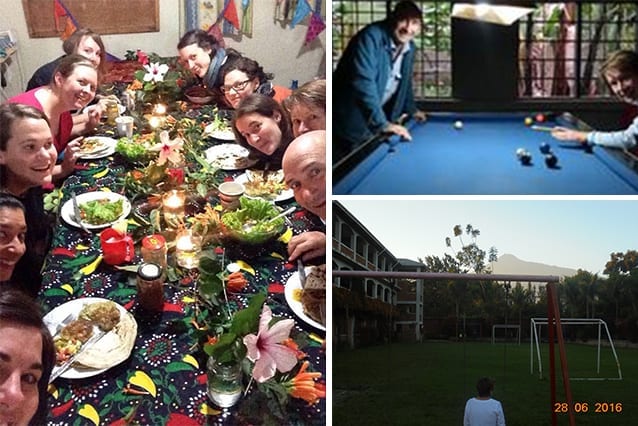
Campus life: The couple loved sharing in the Red kitty kitchen, playing pool at the Waterhole and strolling the grounds of our Moshono campus.
Home visits
Sponsors are welcome to visit their student’s home and meet their family. Victor is in Form 5 and has corresponded with Alex and Wendy for more than a decade. He hosted his sponsors twice so they could meet both his father and mother.
Alex’s Rotary club also sponsors young female student Mwanahawa.
“It’s just humbling, the families were so welcoming they really had so little, but took such pride in hosting us. Victor told us how grateful he was – it’s very humbling,” Alex said.
“Mwanahawa’s family were fasting for Ramadan but for us they put out tea and mandazi (a donut-like snack). Her mother had taken so much care in every detail, in decorating the house and hosting us, it is a real honor to have that opportunity,” Wendy said.
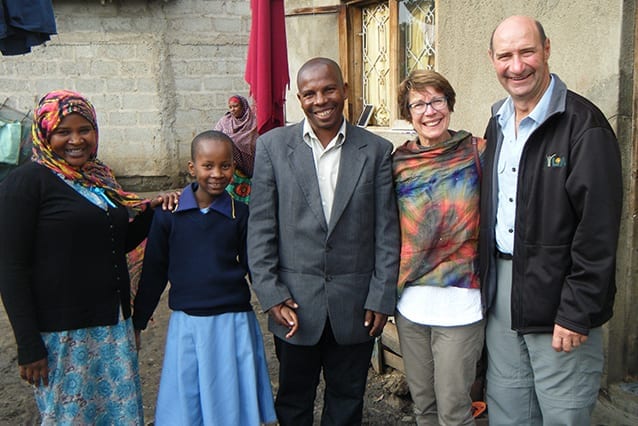
Home sweet home visit: With Mwanahawa's family on one of three home visits.
Safaris: Lake Manyara, Tarangire National Park and Serengeti National Park
“The highlight was actually driving out onto the plain at Lake Manyara and seeing all the zebras, wildebeests and Cape buffalo just there – you feel like you’re in touching distance. The first elephant we saw was way off in the distance and we just stood there staring, amazed. Then we drove up the road about 400 meters and one walked right across in front of the vehicle,” Alex said.
Alex’s boyhood dream of safari wasn’t quite complete without seeing a big cat!
“We didn’t see cats until we went to the Serengeti. Then we saw four leopards, ten lions, two cheetahs and lots of small cats – we even saw lions mating right beside the vehicle,” Alex said.
“Three times!” Wendy added.
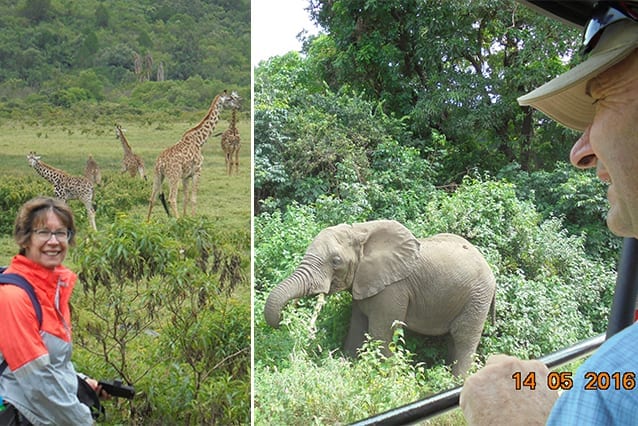
Touching distance: The kiwis couldn't get enough of our local wildlife.
Climbing Mountains: Mt Meru and Mt Kilimanjaro
Living in the shadow of Mt Meru, the daring duo decided it was a must climb. They trained on the steps of the St Jude’s water tower and took every opportunity to walk after work.
“On Meru the environment was so varied there were giraffes at the base and beautiful lichen hanging from the trees like a rainforest. Then when you pass through the clouds, you come out in the hot sun and you’re in scrubland." Wendy said.
“It was a beautiful experience almost ethereal. On the second day the view of Mt Kilimanjaro, at sunrise, floating above the clouds,” Wendy said.
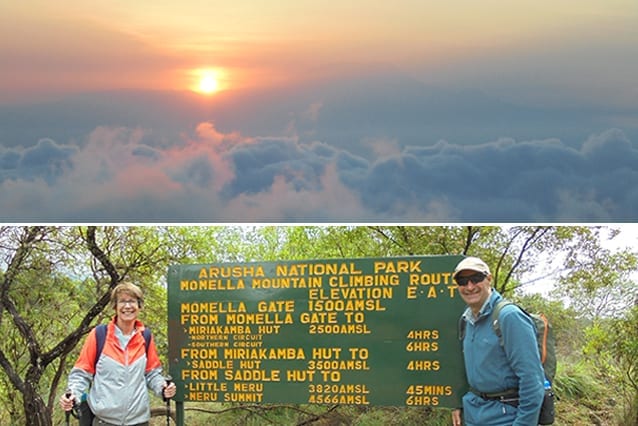
Ethereal experience: The view from Mt Meru of Kilimanjaro at sunrise.
Navigating Arusha/Moshi town
The mountain climbers also mastered the main streets of Arusha and Moshi.
Wendy loved Moshi’s markets with its fresh produce, novelties and tiny alleyways rich with fabric, marvelled at the natural history museum and enjoyed attending church ‘for the singing’.
Alex enjoyed exploring both cities, especially after taking a few Swahili classes so he could spar with street hawkers. Now, almost at the end of their journey, the only thing left is the famous ‘goat street’ - a street where all the eateries serve goat!
.
Their advice to anyone considering a visit:
“Come, just come! The best thing about being involved in St Jude’s is that you can come and see what your donation is doing, appreciate the kids and what’s going on. You can stay in this oasis on campus and then get out and learn so much about Tanzania.” – Alex.
If you want to follow the wise couple's advice, get in touch with our Visitors team and start planning today - We Love Visitors!
Innovation: Check.
Motivation: Check.
Solutions to problems: Of course!
These three primary school students are cutting time and effort out of an everyday job to make life easier for their community.
While the buzz of a lawnmower may be a normal part of any average neighbourhood weekend in the developed world, it’s also the sound of a convenience we often take for granted.
In Tanzania cutting the grass is back-breaking labour, something Grade 7 students Goodluck, Mikidadi and Boniface set their sights on to change.
“We tried to make something that will help in our community,” said Goodluck, whose co-inventors agreed that parents, or their loving kids, would find cutting grass easier with their simple electric lawnmower.
“(Without it) you would use a slasher. It’s very hard work.”
The hard work this innovative trio put into constructing their concept saw them take out third prize in our recent 6th annual Science Fair – the very first time a primary school group has won a spot in the top three!
“We worked on building it for two weeks, but the idea we had for a while before then,” Goodluck explained.
“We feel proud (to have won third place).”
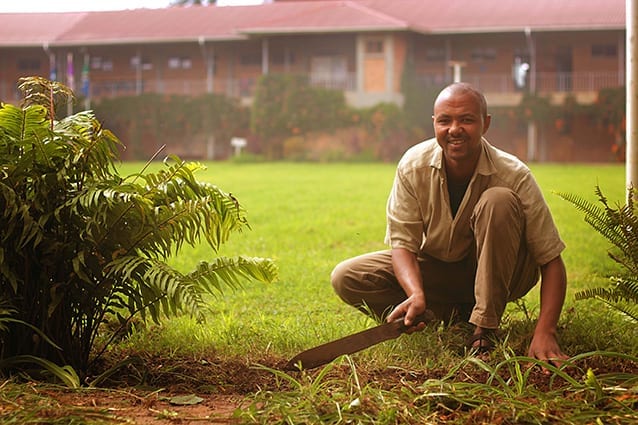
Mr Mcharo, St Jude’s Head of Physical Science Department and Assistant Academic Master, was full of praise for the young inventors.
“Our students have been proving themselves nationally for the last six years but we’ve never had a group of primary school students invent something as impressive as this lawnmower,” Mr Mcharo said.
“We asked the students to come up with solutions for the problems in their communities. What they came up with is a great way to make labor less intensive, and I have confidence that they will integrate solar power in the years to come.”
Boniface, Mikidadi and Goodluck said construction was hard work, but their families were very pleased with them and it was something they were happy to have completed themselves.
They scavenged around for the parts they needed, from materials to build the outer shell, tyres and a fan blade, and asked for some wood glue to help their dream come together.
When the only blade, or fan, they could get ahold of was not made as sturdily as they had wanted, the team saw it simply as a challenge to overcome.
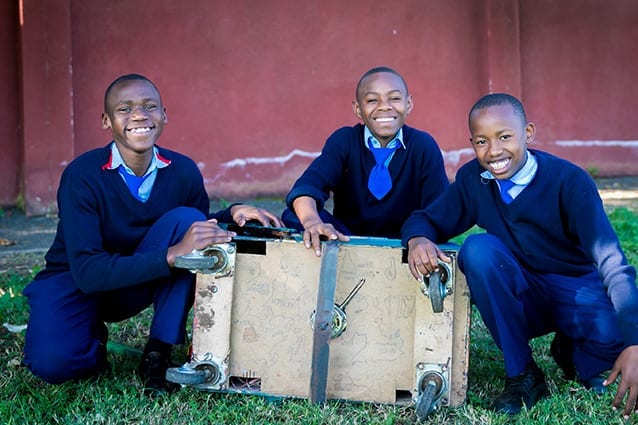
“So we added a switch to add the power. It goes from volume 1 to 3 power,” Boniface said.
“If the grasses are really hard, you would use (volume) 3,” Mikidadi added.
The award-winning team of 14-year-olds plan to continue working together on projects that they have brewing, but are yet to be made official.
“We are still working on ideas,” Goodluck said.
We can’t wait to see what they come up with next!
Show our enthusiastic students some support for their hard work! Donate to Learning Resources today.
From cow dung to insect repellent, industrial waste to bio-gas and plastic bags to building materials; St Jude’s students are applying their first rate scientific education, turning Tanzanian trash into sustainable treasures.
Secondary Headmaster, Nestory Msoffe, was beaming with pride as he inspected over 50 exhibitions from St Jude's students and invited local schools, at the 6th annual St Jude’s Science Day.
“Instead of being content in their circumstances, Science Day gives our students motivation and tools to look for solutions to community challenges and use the resources available to innovate for a better future for our nation,” Mr Msoffe said.
Here's a few examples from the day:
Making plastic fantastic!
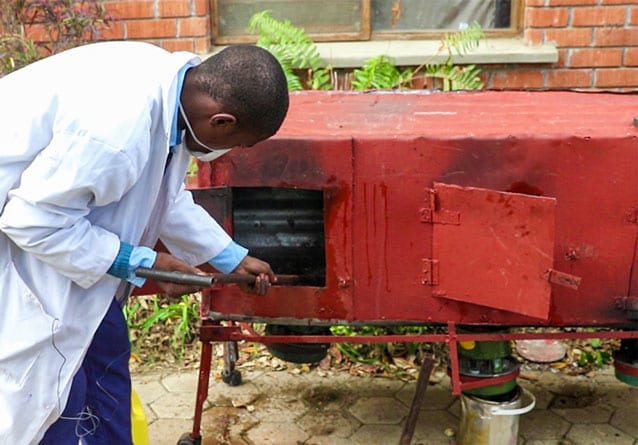
Edgar in Form 3 has been working on his Plastic Recycling project since 2014. He was motivated by the challenges of affordable, durable housing in Tanzania as well as environmental concerns.
“Two years ago, I was in Dar es Salaam and there were terrible floods, most of the people’s houses were mud so they were swept away. They made mud houses because they didn’t have money to construct strong houses.
“Tanzania produces 8 billion plastic bags a year, they end up in the rivers so animals get choked and the bags don’t decompose. You can’t say, ‘stop using plastic bags’, because people have very low income and plastic is cheapest.
“Recycling them is the only way to reduce pollution,” he said.
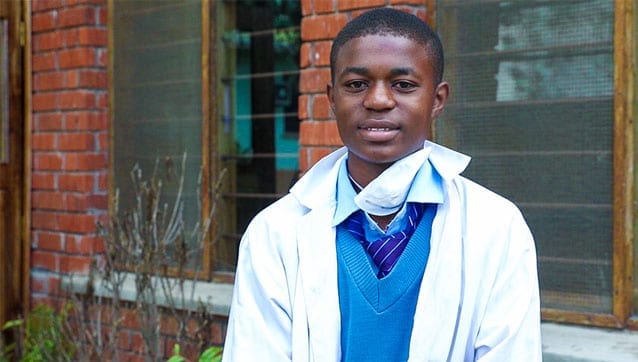
Edgar’s innovation comprises a custom-made metal burner in which he melts plastic bags and combines them with a few other 'secret ingredients' before transferring the mixture into handmade molds to make roof tiles, paving tiles and bricks.
“Tanzania doesn’t produce any roof tiles, most of them are imported from South Africa. If you could recycle plastic bags to make roof tiles, bricks and paving, you could create a whole industry that will give employment to the youth and contribute to development,” Edgar said.
The tenacious teen is still innovating, not content with a first place prize he is looking for materials to incorporate a carbon capture mechanism, of his own design, into the melting machine.
Edgar is also looking to bio-gas options to replace his natural gas burners.
Waste not want not!
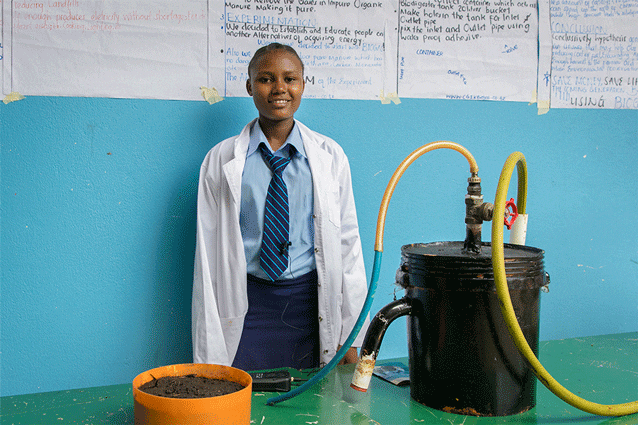
Clara, also in Form 3, took out the prestigious Chairman’s Award for her innovation in sustainable energy sources.
With help from her friends and staff supervisor, Mr Amani, the aspiring medical doctor produced bio-gas using cow dung, bacteria, potassium hydroxide, a handful of buckets and pipes, and some cement for sealing.
“Many gases are produced from the decomposition of cow dung using saprophytic bacteria, the main product is methane, which can be very useful,” Clara said.
“When the gases are combusted, they produce bio-gas and can be connected to a gas cylinder which you can use for heating and cooking purposes and can be compressed to produce electricity.
“By using agricultural waste, municipal waste, green waste, sewage and animal waste to make bio-gas, we can make heating and electricity more available, we can lower pollution and deforestation in our environment and save money,” Clara said.
Household Heroes!
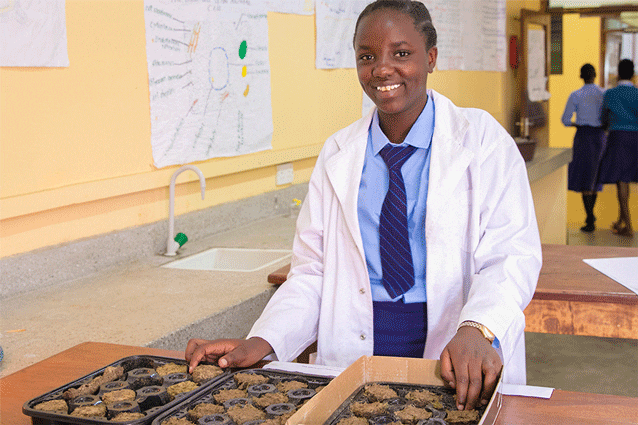
Herbal insect repellent made by Juma, Martin and Kilimba (Form 3) out of cow dung and pine needles. When it is burned it can last for many hours and is much cleaner and cheaper than mosquito coils.
“Mosquito coils are not good for you in small spaces, they are like smoking 137 cigarettes,” Kilimba said.
Organic disinfectant using rice, water and fermented milk bacteria, Aneth and Sesilia (Form 3) produced a low-cost, effective disinfectant with applications as varied as unblocking drains, decomposing waste and treating livestock for disease.
"The mixture must be activated with sugar and with the right ratio of molasses to disinfectant; it can be stored for up to 3 years," Aneth said.
Shoe polish – charcoal, water and glycerin combined to make a nifty, low-cost shoe polish. This entry was submitted by Shepherds School, one of the eight local schools who participated in the day.
Crowd Favourites!
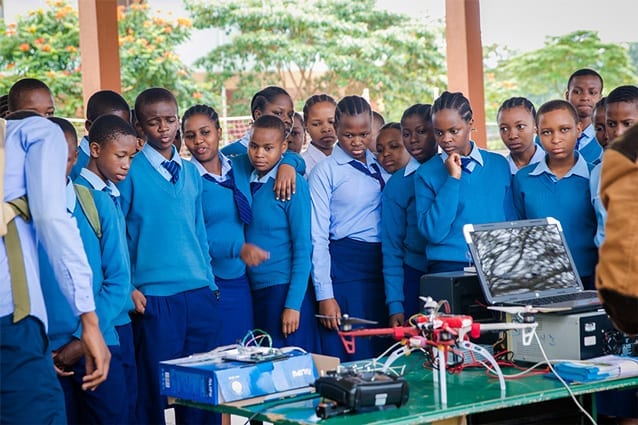
Quadcopter Anti-poaching System - The Kilimanjaro International Institute for Telecommunications exhibited a drone, programmed to monitor national parks and alert authorities to the presence of poachers.
"Thirty elephants are killed in Tanzania’s national parks every week, we need to put an end to this," KIIT staff representative, Lui J Ayo said.
Sensor walking stick - Arusha Technical College displayed a walking stick that vibrates when there is a dip in the ground ahead and beeps when there is an obstacle. Students took turns testing it out all afternoon.
"There are many blind people who need full time assistance, with a tool like this, they will be made much more independent and their helper will be freed up to work and bring in some money," ATC student Samoni said.